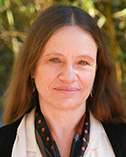
Linda R. Petzold
University of California, Santa Barbara
|
Primary Section: 32, Applied Mathematical Sciences Secondary Section: 29, Biophysics and Computational Biology Membership Type:
Member
(elected 2021)
|
Biosketch
Linda Petzold is an applied mathematician and computer scientist. She is known particularly for her work on computational algorithms and public-domain software, for the solution of differential-algebraic equations and for discrete stochastic simulation. Petzold was born and grew up in Chicago, Illinois. She graduated from the University of Illinois at Urbana-Champaign (UIUC) with a degree in mathematics and computer science in 1974, and with a Ph.D. in Computer Science from UIUC in 1978. She was a member of the technical staff in the Applied Mathematics Division of Sandia National Laboratories in Livermore California from 1978-1985, and was Group Leader of the Numerical Mathematics Group at Lawrence Livermore National Laboratory from 1985-1991. She was a Professor in the Department of Computer Science at the University of Minnesota from 1991-1997. In 1997 she joined the University of California Santa Barbara as a Professor in the Departments of Mechanical Engineering and Computer Science. She is a member of both the National Academy of Sciences and the National Academy of Engineering.
Research Interests
Linda Petzold’s research focuses on modeling, simulation and data analytics for multiscale systems in biology, engineering and medicine. She is best known for her pioneering work on the numerical solution of differential-algebraic equations (DAEs). Her software, DASSL and its successor DASPK for the numerical solution of DAEs, are widely used throughout science, engineering and technology. She has also made seminal contributions in the area of systems biology. Much of her work in this area has focused on the development of computational techniques for the discrete stochastic simulation of multiscale biochemical systems. In microscopic systems formed by living cells, small numbers of key reactant molecules can result in dynamical behavior that is discrete and stochastic (random), rather than continuous and deterministic. In simulating and analyzing such behavior it is necessary to employ numerical methods that directly take into account the underlying discrete stochastic nature of the molecular events. She has developed widely used computational software for discrete stochastic simulation, including StochSS Live!. Using these techniques and others, she has made important advances in a wide range of problems from biology and medicine, including Circadian rhythm, unfolded protein response, cell polarization, migraine and trauma.

